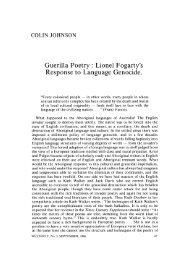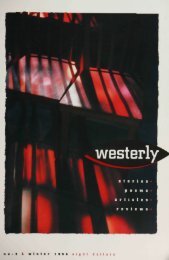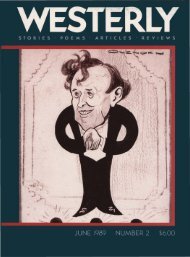and feelings of his people or of the meaningof our modern life. With respect, I have tosay that these excursions often remind one ofthe novelette. Consider this passage from Seed:Valerie was aware, as she had been at timesbefore, of the fear she felt Marlene had ofher own nature, as if she saw herself drivenand destroyed by what she desired and couldnot compromise. For Valerie it was no morethan a glimpse into a complexity she did notwholly understand and was glad to feelabsent from her own make-up. Almost shemight have disbelieved the girl's statementof need, dismissing it as some dramatisation,it seemed so far from her own experience.But the intensity of Marlene's feeling, thestrange agony that she had seen possess her,the sense of fear, all of which could sometimesforce her to complete rejection of consequence,were real enough, though she didnot understand them, (p.255)Reading this, an analysis of one schoolgirl'sreactions to another, one feels the women'sm.agazine not far away.When Mr Cowan mounts his hobby horse—the spoliation of our natural environment bythe ugly mass of cities and city-dwellers—theprose is even more self-conscious, so that onefinds oneself (after encountering these ideasmore than once) saying, 'Ah, here comes theLewis Mumford-Rachel Carson bit'. This isdoubtless unfair, but it records the extent towhich the author has not worked his ideas intothe fabric of his narratives or attributed themconvincingly to his characters.This last criticism has a wider application,because it explains why the author often unwittinglyundercuts his carefully contrived realism.The range of characters in Peter Cowan'sstories and novels is not large—indeed, hisrange is in all respects narrow, so that overmany years his work remains remarkably unvaried—andthen tend to exist as recurrenttypes. In each tale there is usually one consciousnesswhich is closest to the author's, understandablyenough, but it often happens thatthe thoughts and expressions attributed to thischaracter are implausible. We know them to becharacteristic of Mr Cowan; they are hardlycredible as typical of the figures in the stories.The chief index to this disparity between acharacter and his putative thoughts and feelingsis the way he or she talks. Mr Cowan'ssense of language is not strong, and so hehas, for instance, a habit of intruding into apassage of flat but credible dialogue a word orphrase which strikes one as highly unlikely forthe character speaking it. In 'Film', a womanwho otherwise uses expressions like 'quite anice room', 'a special night', 'the magic wearsoff', says of herself at the films that she is'living vicariously'. In 'Party' a young farmerwho has studied accountancy but never readsbooks says he is 'just literate'. In Seed, aschoolboy, Nigel, is put in possession of an implausiblerange of sensations and the vocabularyto express them, at least to himself.I said above that Peter Cowan's charactersand stories are credible. This is true of thestories despite their recurrent violence; theauthor does in fact convey to us the sensethat the end result of suburban tidiness andurban industry may be madness, murder anddestruction. The quota of violent action is high,and yet beUevable. Of the characters it mightbe more accurate to say they are 'recognisable'than 'credible', for we hardly know any ofthem deeply.Insofar as we do know them, assent is possibleto much of what is said of the drearinessand pointlessness of their lives. But many ofMr Cowan's attitudes—his automatic criticismof suburbia, fihns, city life—strike me as rathervoulu; like his outcry against the developers,one feels he first got it from a book, that heis merely repeating modish views.If this is so, he is not working with the thewand sinew of Australian life but with the preconceptionsand misunderstandings of the 'intellectuals'.In this respect he does remind oneof Patrick White. Peter Cowan is a gentler soulthan White; his picture of Perth in Seed isseveral degrees less sharp than the savage depictionof Sarsaparilla. But the essential incomprehensionis similar, so that one has to say ofboth novelists that they do not really know thepeople they write of.In the end, then, I believe one values PeterCowan for what he attempts rather than whathe succeeds in. He tries, without mystificationor pomp, to understand and render the quotidianlife of mid-century Austraha; to recreatein fiction the lives of his countrymen honestlyand accurately; to image forth the look of theland, the water, the birds, the animals, thepeople. If it is a dull, monotonous renderingthis is at least partly because in his vision ofAustralia these are the authentic quaUties ofour life: we have deserted the land with itsnatural rhythms, its peace, and its wild Ufe,and immured ourselves in ugly cities. The pricewe pay (he seems to suggest) is a witheringof the spirit.But it is also partly, I am sure, because ofthe incompleteness of his vision and of hisequipment to render it. The savour, vigour andgenuine happiness of our life he does not ade-68 WESTERLY, No. 1 of 1967
quately convey, so that his characters are oftenstiff, self-conscious, bookish and sombre wherethey should be relaxed, good-humoured andcontented. Whether the absence from MrCowans fictions of gaiety, optimism andhumour is the result of temperament or doctrineone cannot know; but it deprives them ofimpact and veracity. We recognise but do notinhabit his joyless world.Wordsworth and the Artist's Vision: An Essayin Interpretation. Alec King, The AthlonePress, the University of London, 1966. Pp. 181.Professor King's book, Wordsworth and theArtist's Vision, is both novel and interesting.Much of both the novelty and the interest liesin Professor King's attitude which is neitherthat of the philosophic historian nor strictlythat of the Hterary critic. What he offers insteadis a series of insights set against a backgroundof artistic experience and religious tradition.The central insight is into the nature ofWordsworth's vision (and "vision" here has anentirely proper ambiguity). There has beensome interest lately in the sort of abnormalconsciousness that Blake seems to describe,and there have even been experiments in deliberatederangement, such as Aldous Huxley'swith mescahne, but as Northrop Frye drylyremarks, this is not precisely what Blake meantby "cleansing the doors of perception". ProfessorKing opens a much more suggestive andimportant line by making clear the similaritybetween Wordsworth's description of the vision(and its consequences) and descriptions of artisticvision by a number of major painters.For both this vision arises out of the interactionof the outer world and the inner life."The so-called distortions of the painter's artare the sign that he is not describing naturebut an active relationship in which the unionof the personal and the objective is rhythmicallydelighted in". True sight, in fact, is alsoinsight.This comparison, of course, puts the Visionfirmly where Wordsworth himself placed it, inthe physical and mental act of seeing. HereProfessor King quotes Matisse, "to see is itselfa creative operation, requiring an effort". Atthe same time this act by which the forms ofthe outward world enrich the inner life is, forboth Wordsworth and the artists, the act ofdiscovering the life of the world and the divinewhich is in it (Professor King rightly remarksthat in this context "God" is not the poeticallyappropriate word).From this the book moves to deal, in successivechapters, with Wordsworth's descriptionsof the life of the world and the mind,with moral being, and with childhood and thestate of grace. The exposition itself is not radicallynew but the understanding which ProfessorKing draws from his experience ofvisual art and from his sensitivity to the implicationsof religious feeling make his accountvery real and illuminating. He then goes onto relate Wordsworth's simple style to hisfeeling for 'things' and makes an interestingcomparison between his style and the sculpturalstyle of Henry Moore. Oddly, he doesnot here treat the style Wordsworth uses forhis more visionary landscapes, and earlier remarksthat the apocalyptic vision on the Simp-Ion Pass is "consciously in the style of 'TheSublime School' ", though the chapter in whichthis occurs brings out very powerfully theapocalyptic quality of the Vision itself.A further chapter relates Wordsworth's styleto his sensitiveness to the inner life of feelingand a final chapter, relating Wordsworth to thechanges that came before and after him inscientific and religious thought, argues stronglyfor his relevance to our own day.The book is easily and gracefully written,but its greatest virtue is its focus. It bringsout in Wordsworth's poetry those things whichthe poet himself placed at the centre, and itsunderstanding of the poet is never eccentric.It is infinitely more successful in its attempt toshow Wordsworth as relevant today than were,for instance, the attempts of the Americanlatter-day transcendentalists to revive theWordsworth of 1805 and after as a professionalphilosopher. It clarifies Wordsworthwithout distorting him and among its othervirtues, it should be a most useful book withundergraduates, because it grounds his meaningin experience. At the same time, it is perhapsa compliment rather than a complaintthat Professor King's comparatively shortstudy makes one want to go behind it andbeyond it. One thing one notices is that theartists quoted here, and there are many ofthem, range in time only from Delacroix toMatisse and Chagall, and that the theologiannamed is the Bishop of Woolwich (who canpresumably be taken as embracing the radicalWESTERLY. No. 1 of 1967 69
- Page 1 and 2:
arc de triomphe
- Page 3 and 4:
westerlya quarterly reviewEDITORIAL
- Page 5:
westerlyNo. 1 of 1967CONTENTSSTORIE
- Page 8 and 9:
"Oh, old Jack's morals are alright
- Page 10 and 11:
were looking down on a face so scru
- Page 12 and 13:
in the comfort of cars. Ellie and T
- Page 14 and 15:
grand, final fling. His bright eyes
- Page 16 and 17:
The rotting wood in the window fram
- Page 18 and 19:
John lumbered up the steps of the G
- Page 20 and 21:
night storm that flashed and twinkl
- Page 22 and 23:
Quietly the young man left to fetch
- Page 24 and 25: "Bother, I've forgotten your aktavi
- Page 26 and 27: patiently as she hesitated. What wa
- Page 28 and 29: THEUNIVERSITYBOOKSHOPAT THE UNIVERS
- Page 30 and 31: PREFACE(Emaux et Camees)Pendant les
- Page 32 and 33: NOELLe ciel est noir, la terre est
- Page 34 and 35: LA DERNIERE FEUILLEDans la foret ch
- Page 36 and 37: LES COLOMBESSur le coteau, 1^-bas o
- Page 38 and 39: LA MONTREDeux fois je regarde ma mo
- Page 40 and 41: FUMEELa-bas, sous les arbres s'abri
- Page 42 and 43: PENDANT LA TEMPETELa barque est pet
- Page 44 and 45: PAYSAGEPas une feuille qui bouge,Pa
- Page 46 and 47: LE MERLEUn oiseau siffle dans les b
- Page 48 and 49: LETRILLAEnfant, pourquoi tant de pa
- Page 50 and 51: L'ARTOui, I'oeuvre sort plus belleD
- Page 52 and 53: ARTYes, lovelier do works of artEme
- Page 54 and 55: Some JOURNALS published byUNIVERSIT
- Page 56 and 57: But the two Town Planners did not j
- Page 58 and 59: The years 1963-65, therefore, were
- Page 60 and 61: COCD00(Moasu;-(a!CocP4Q
- Page 62 and 63: •OS. ^ " ^-«w" 1 a 1-1* r^^ril1
- Page 64 and 65: —representing one home in about 5
- Page 66 and 67: ingly in the determination of its p
- Page 68 and 69: For a personal view. Westerly asked
- Page 70 and 71: Abrolhos Islands, is believed to ha
- Page 72 and 73: added dimension of individual human
- Page 76 and 77: theological developments of the las
- Page 79 and 80: IF YOU DON T KNOW HOWDON'T DO IT•







